Submitted by chandra on Thu, 2012-08-30 10:42
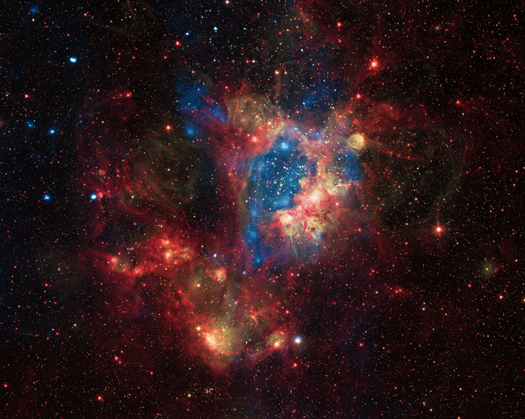
This composite image shows a superbubble in the Large Magellanic Cloud (LMC), a small satellite galaxy of the Milky Way, located about 160,000 light years from Earth. Many new stars, some of them very massive, are forming in the star cluster NGC 1929, which is embedded in the nebula N44. The massive stars produce intense radiation, expel matter at high speeds, and race through their evolution to explode as supernovas. The winds and supernova shock waves carve out huge cavities called superbubbles in the surrounding gas. X-rays from NASA's Chandra X-ray Observatory (blue) show hot regions created by these winds and shocks, while infrared data from NASA's Spitzer Space Telescope (red) outline where the dust and cooler gas are found. The optical light from the 2.2m Max-Planck-ESO telescope (yellow) in Chile shows where ultraviolet radiation from hot, young stars is causing gas in the nebula to glow.
Submitted by chandra on Tue, 2012-04-17 10:26

To celebrate its 22nd anniversary in orbit, the Hubble Space Telescope has released a dramatic new image of the star-forming region 30 Doradus, also known as the Tarantula Nebula because its glowing filaments resemble spider legs. A new image from all three of NASA's Great Observatories - Chandra, Hubble, and Spitzer - has also been created to mark the event.
Submitted by chandra on Thu, 2011-11-10 12:54
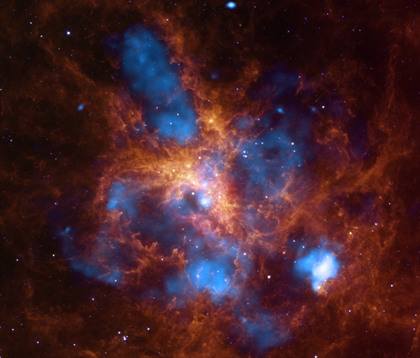
The star-forming region, 30 Doradus, is one of the largest located close to the Milky Way and is found in the neighboring galaxy Large Magellanic Cloud. About 2,400 massive stars in the center of 30 Doradus, also known as the Tarantula Nebula, are producing intense radiation and powerful winds as they blow off material.
Submitted by chandra on Wed, 2011-09-28 11:05
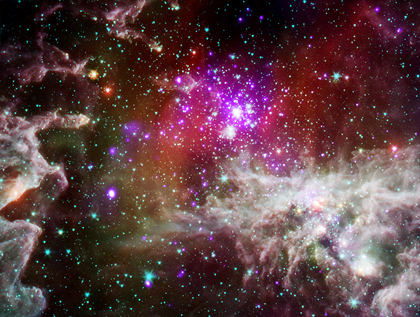
High-mass stars are important because they are responsible for much of the energy pumped into our galaxy over its lifetime. Unfortunately, these stars are poorly understood because they are often found relatively far away and can be obscured by gas and dust. The star cluster NGC 281 is an exception to this rule. It is located about 9,200 light years from Earth and, remarkably, almost 1,000 light years above the plane of the Galaxy, giving astronomers a nearly unfettered view of the star formation within it.
Submitted by chandra on Tue, 2011-09-13 12:03
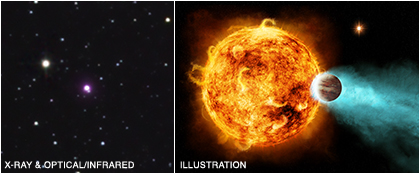
This graphic contains an image and illustration of a nearby star, named CoRoT-2a, which has a planet in close orbit around it. The separation between the star and planet is only about 3 percent of the distance between the Earth and the Sun, causing some exotic effects not seen in our solar system.
Submitted by chandra on Tue, 2011-05-24 11:12

This large Chandra image shows the Carina Nebula, a star-forming region in the Sagittarius-Carina arm of the Milky Way a mere 7,500 light years from Earth. Chandra's sharp X-ray vision has detected over 14,000 stars in this region, revealed a diffuse X-ray glow, and provided strong evidence that massive stars have already self-destructed in this nearby supernova factory.
Submitted by chandra on Wed, 2011-04-13 09:50
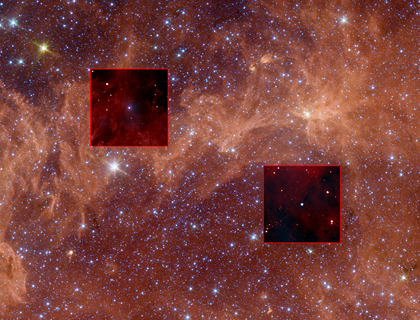
Like looking for Easter eggs in a lawn of long grass, the hunt for the Milky Way's most massive stars takes persistence and sharp eyes. In their stellar search through our Galactic backyard, astronomers have used powerful telescopes sensitive to X-ray and infrared radiation to find evidence for a substantial population of X-ray emitting massive stars.
Submitted by chandra on Thu, 2011-02-24 14:03
Lately, we’ve been noticing some great new videos that are covering some basic – yet hard-to-understand – concepts in astronomy. Here’s one we recently saw, featured on “Astronomy Picture of the Day,” that we thought was worth noting: http://apod.nasa.gov/apod/ap110222.html

Submitted by chandra on Tue, 2010-09-14 11:20
The composite image on the left shows X-ray and optical data for BP Piscium (BP Psc), a more evolved version of our Sun about 1,000 light years from Earth. Chandra X-ray Observatory data are colored in purple, and optical data from the 3-meter Shane telescope at Lick Observatory are shown in orange, green and blue. BP Psc is surrounded by a dusty and gaseous disk and has a pair of jets several light years long blasting out of the system. A close-up view is shown by the artist's impression on the right. For clarity a narrow jet is shown, but the actual jet is probably much wider, extending across the inner regions of the disk. Because of the dusty disk, the star's surface is obscured in optical and near-infrared light. Therefore, the Chandra observation is the first detection of this star in any wavelength.
Submitted by chandra on Wed, 2010-09-08 11:04
This composite image shows the Rosette star formation region, located about 5,000 light years from Earth. Data from the Chandra X-ray Observatory are colored red and outlined by a white line. The X-rays reveal hundreds of young stars in the central cluster and fainter clusters on either side. Optical data from the Digitized Sky Survey and the Kitt Peak National Observatory (purple, orange, green and blue) show large areas of gas and dust, including giant pillars that remain behind after intense radiation from massive stars has eroded the more diffuse gas.
Pages